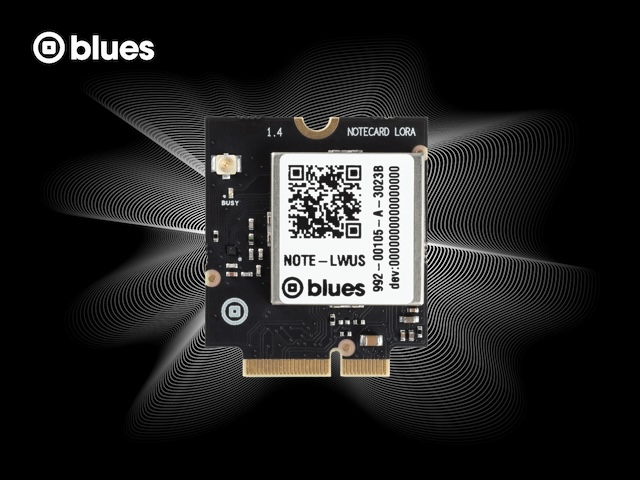It’s a big day at Blues, as today we’re happy to announce the general availability of Notecard LoRa to enable LoRa/LoRaWAN in the IoT 🎉
What is Notecard LoRa?
Notecard LoRa is a low-cost ($10!) version of the Notecard that uses LoRa-based communication exclusively.

If you’ve heard of Blues before it’s probably for our Cellular Notecard, which drastically simplifies the complexity of building wireless products that communicate over cellular networks.
With Notecard LoRa we’re applying the developer-friendly design our users love from our Cellular Notecard and applying them to LoRa. With some simple JSON-based configuration, you can starting sending data to the cloud over LoRaWAN in minutes—with no complex device registration or provisioning required. Much like the Cellular and Wi-Fi Notecard, you can program the Notecard LoRa over USB, or control it from your preferred microcontroller or single-board computer using one of our open-source firmware libraries.
Using a LoRa radio, devices can communicate over a mile in urban areas, up to 5 miles in rural areas, and use so little power a battery can last years. This makes the Notecard LoRa ideal for scenarios that use low amounts of data, areas where cellular coverage isn’t present, or solutions that need to rely solely on battery power for years at a time. The Notecard LoRa supports The Things Stack gateways, and includes a flexible Molex 211140 antenna that supports both 868 MHz (Europe) and 915 MHz (United States) frequencies.
How do you get started?
Starting with LoRa has historically been intimidating, as building a full LoRaWAN architecture involves finding, purchasing and configuring a LoRaWAN gateway, followed by setting up network and application servers to handle data flowing throughout your system.
Here at Blues we think we can make this process considerably easier, which is why today we’re also announcing the availability of the Blues LoRaWAN Starter Kit.

This $199 kit ships with everything you need to get started with building around LoRa and LoRaWAN. It includes a Blues Indoor LoRaWAN Gateway (pre-provisioned to work on The Things Stack), three Notecard LoRas, three Notecarrier Bs, and three LiPo batteries to power it all.
With the Blues LoRaWAN Starter Kit, getting started with LoRa is as easy as connecting the included gateway to Ethernet or Wi-Fi, assembling a few Notecard-based devices, and configuring each Notecard using a JSON-based API. We put it all together into an easy-to-follow tutorial you can skim now and follow after you have your kit.
So what are you waiting for? Get your Blues LoRaWAN Starter Kit today! And let us know what questions you have for us in the comments. We can’t wait to see what you build.


